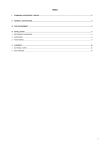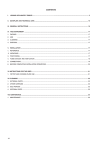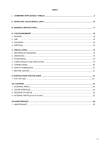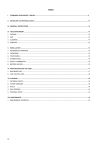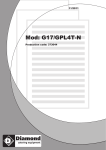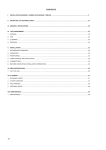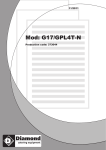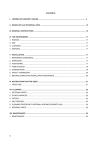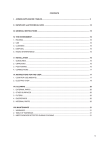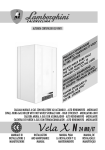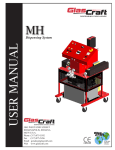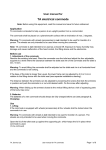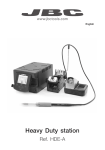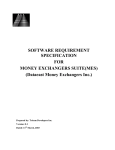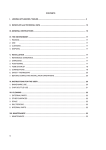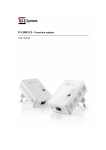Download User Manual - SharePoint
Transcript
INDEX I. COMBINING APPLIANCES / TABLES....................................................................................................................................... 2 II. DATAPLATE and TECHNICAL DATA......................................................................................................................................... 19 III. GENERAL INSTRUCTIONS........................................................................................................................................................ 21 IV. THE ENVIRONMENT.................................................................................................................................................................. 23 1.PACKING .................................................................................................................................................................................... 23 2.USE .................................................................................................................................................................................... 23 3.CLEANING................................................................................................................................................................................... 23 4.DISPOSAL................................................................................................................................................................................... 23 V.INSTALLATION........................................................................................................................................................................... 23 1. REFERENCE STANDARDS........................................................................................................................................................ 23 2. UNPACKING................................................................................................................................................................................ 23 3. POSITIONING.............................................................................................................................................................................. 24 4. FUME EXHAUST ........................................................................................................................................................................ 24 5. CONNECTIONS........................................................................................................................................................................... 24 6. BEFORE LEAVING...................................................................................................................................................................... 26 VI. INSTRUCTIONS FOR THE USER................................................................................................................................................ 27 1. GRILL USE.................................................................................................................................................................................. 27 VII. CLEANING.................................................................................................................................................................................. 28 1. EXTERNAL PARTS...................................................................................................................................................................... 28 2. OTHER SURFACES..................................................................................................................................................................... 28 3.IDLE PERIODS............................................................................................................................................................................ 28 4. INTERNAL PARTS....................................................................................................................................................................... 28 VIII. MAINTENANCE.......................................................................................................................................................................... 30 1. MAINTENANCE........................................................................................................................................................................... 30 18 II. DATAPLATE and TECHNICAL DATA IMPORTANT This manual contains information relevant to various appliances. See the appliance dataplate located under the control panel in order to identify the appliance (see fig. above). TABLE A - Gas/Electric appliance technical data - N7E MODELS +7GRGDGCFU 400mm TECHNICAL DATA Burners +7GRGHGCFU 800mm +7GREDGCFU 400mm +7GREHGCFU 800mm +7GRGDLC00 400mm +7GRGHLC00 800mm +7GREDGS0U 400mm +7GREHGS0U 800mm No. 1 2 - - 1 2 - - Ø 1/2" 1/2" - - 1/2" 1/2" - - kW 8 16 - - 7 14 - - A1 A1 - - A1 A1 - - V - - 380-400 380-400 - - 380-400 380-400 Phases No. - - 3N 3N - - 3N 3N Frequency Hz - - 50/60 50/60 - - 50/60 50/60 kW - - 5,4-6 10,8-12 - - 3,6-4 7,2-8 mm2 - - 2,5 4 - - 2,5 4 ISO 7/1 connection Nominal heat output Type of construction Power supply voltage Max. Power Power cable section TABLE A - Gas/electric appliance technical data - N9E MODELS +9GRGDGCFU TECHNICAL DATA 400mm +9GRGHGCFU 800mm +9GRTDGCFU 400mm +9GRTHGCFU 800mm +9GREDGCFU 400mm +9GREHGCFU 800mm ISO 7/1 connection / BS/P Connection Ø 3/4" 3/4" 3/4" 3/4" - - Burners No 1 2 1 2 - - Nominal heat output kW Type of construction Power supply voltage V 10 20 10 20 - - A1 A1 A1 A1 - - - - - - 380-400 380-400 Phases No. - - - - 3+N 3+N Frequency Hz - - - - 50/60 50/60 kW - - - - 6,8-7,5 13,5-15 mm2 - - - - 1,5 2,5 Max. total power Power supply cable section 19 A reproduction of the marking or data plate on the machine is given below: GAS EL. The meaning of the various information given on it is listed below: Cat........................................... Gas Category Pmbar...................................... Gas pressure F.Mod....................................... factory description of product Comm.Model........................... commercial description PNC......................................... production number code Ser.No .................................... serial number El:............................................ power supply voltage+phase Hz:........................................... power supply frequency kW:.......................................... max. power input A.............................................. current absorption Power unit El.:.......................... power I .............................................. dust and water protection rating CE ........................................... CE marking AB............................................ gas safety certificate number N.............................................. certification group 0051........................................ notified body EN 203-1................................. EU standard L.............................................. Logo INQ/GS 20 Electrolux Professional SPA Viale Treviso, 15 33170 Pordenone (Italy)Manufacturer When installing the appliance, make sure the electrical connection is carried out in compliance with that specified on the dataplate. III. GENERAL INSTRUCTIONS • Read the instruction manual carefully before using the appliance. • Keep the instruction handbook for future reference. • RISK OF FIRE - Keep the area around the appliance free and clear of combustibles. Do not keep flammable materials in the vicinity of this appliance. • Install the appliance in a well-ventilated place • Air recirculation must take into account the air necessary for combustion, 2 m³/h/kW of gas power, and also the “well-being” of persons working in the kitchen. • Inadequate ventilation causes asphyxia. Do not obstruct the ventilation system in the place where this appliance is installed. Do not obstruct the vents or ducts of this or other appliances. • Place emergency telephone numbers in a visible position. • Installation and maintenance must only be carried out by qualified personnel authorised by the manufacturer. For assistance, contact an authorised service centre. Demand original replacement parts. • This appliance is designed for cooking food. It is intended for industrial use. Any use different from that indicated is improper. • The appliance must not be used by people (including children) with limited physical, sensory or mental abilities or without experience and knowledge of it, unless instructed in its use and supervised by those responsible for their safety. • The appliance must be used by trained personnel about the risks involved. • Do not leave the appliance unattended when operating. • Turn the appliance off in case of fault or poor operation. Do not use products (even if diluted) containing chlorine (sodium hypochlo• rite, hydrochloric or muriatic acid, etc.) to clean the appliance or the floor under it. Do not use metal tools to clean steel parts (wire brushes or Scotch Brite type scouring pads). • Do not store or use gasoline or other flammable vapours, liquids or items in the vicinity of this or any other appliance. • Never check for leaks with an open flame. • The appliance is not suitable for a marine environment. • Do not allow oil or grease to come into contact with plastic parts. 21 • Do not allow dirt, fat, food or other residuals to form deposits on the appliance. • Do not clean the appliance with direct jets of water. • Do not spray water or use steam to clean the equipment. • The level of A-weighted emission sound pressure does not exceed 70 dB (A). • This handbook is available in digital format by contacting the dealer or reference customer care. • Install a circuit breaker ahead of the appliance. The contact opening distance and max. leakage current must comply with the regulations in force. • The appliance must be earthed; Connect to appliance to an earth; it must be included in an equipotential node by means of the screw located under the . frame. The screw is marked with the symbol • It is advisable to have the appliance inspected by an authorised person at least every 12 months. For this purpose, it is advisable to stipulate a servicing contract. L • The symbol given on the product indicates that it should not be considered domestic waste, but must be correctly disposed of in order to prevent any negative consequences for the environment and the health of persons. For further information regarding the recycling of this product, contact the product agent or local dealer, the after-sales service or the local body responsible for waste disposal. Failure to observe the above can compromise the safety of the appliance. Failure to observe the above invalidates the warranty. 22 IV. THE ENVIRONMENT V.INSTALLATION 1.PACKING • Carefully read the installation and maintenance procedures given in this instruction manual before installing the appliance. • Installation, maintenance and conversion to another type of gas must only be carried out by qualified personnel authorised by the manufacturer. • Failure to observe the correct installation, conversion and modification procedures can result in damage to the appliance, danger to people, and invalidates the Manufacturer’s warranty. The packing materials are environmentally friendly and can be stored without risk or burned in an appropriate waste incineration plant. Recyclable plastic components are marked with: Polyethylene: outer wrapping, instruction booklet bag, gas nozzle bag. polypropylene: roof packing panels, straps. Polystyrene foam: corner protectors. 2.USE Our appliances offer high performance and efficiency. To reduce electricity, water or gas consumption, do not use the appliance empty or in conditions that compromise optimum efficiency (e.g. with doors or lids open, etc.); the appliance must be used in a well-ventilated place, to avoid the creation of dangerous mixtures of unburnt gases in the room. When possible, preheat only before use. 3.CLEANING In order to reduce the emission of pollutants into the environment, clean the appliance (externally and when necessary internally) with products that are more than 90% biodegradable (for further information refer to section VII “CLEANING”). 4.DISPOSAL Do not disperse in the environment. Our appliances are manufactured using more than 90% (in weight) recyclable metals (stainless steel, iron, aluminium, galvanised sheet, copper, etc.). Make the appliance unusable by removing the power cable and any compartment or cavity closing devices (when present) in order to avoid the risk of someone becoming trapped inside. 1. REFERENCE STANDARDS • Install the appliance in accordance with the safety regulations and local laws of the country where used. • AUSTRALIA: this appliance shall be installed only by authorised persons and in accordance with the manufacturer’s installation instructions, local gas fitting regulations,municipal building codes, electrical wiring regulations, local water supply regulations, AS5601-gas installation, health authorites and any other statutory regulations. 2.UNPACKING IMPORTANT! Immediately check for any damage caused during transport. • The forwarder is responsible for the goods during transport and delivery. • Inspect the packing before and after unloading. • Make a complaint to the forwarder in case of visible or hidden damage, reporting any damage or shortages on the dispatch note on delivery. • The driver must sign the dispatch note: The forwarder can reject the claim if the dispatch note is not signed (the forwarder can provide the necessary form). • Unpack, taking care not to damage the equipment. Wear protective gloves. • Carefully remove the protective film from metal surfaces and clean any traces of glue with a suitable solvent. • For hidden damage or shortages becoming apparent only after unpacking, request the forwarder for inspection of the goods within and not later than 15 days of delivery. • Keep all the documentation contained in the packing. 23 3.POSITIONING • Handle the equipment with care in order to avoid damage or danger to persons. Use a pallet for handling and positioning. • The installation diagram given in this instruction manual gives the appliance dimensions and the position of connections (gas, electricity, water). Check that they are available and ready for making all the necessary connections. • The appliance can be installed separately or combined with other appliances of the same range. • The appliances are not designed for built-in installation. Leave at least 10 cm between the appliance and side or rear walls. • Suitably insulate surfaces that are at distances less than those recommended. • Maintain an adequate distance between the appliance and any combustible walls. Do not store or use flammable materials and liquids near the appliance. • Leave an adequate space between the appliance and any side walls in order to enable subsequent servicing or maintenance operations. • Check and if necessary level the appliance after positioning. Incorrect levelling can cause appliance malfunctioning. 3.1. COMBINING APPLIANCES • (Fig.1A) Undo the 4 fixing screws and remove the control panels of the appliances. • (Fig.1B) Remove the fixing screw nearest the control panel, from each side to be joined. • (Fig.1D) Bring the appliances together and level them by turning the feet until the tops match. • (Fig.1C) Turn one of the two plates inside the appliances 180º. • (Fig.1E) From inside the control panel of the same appliance, join them at the front side, screwing one TE M5x40 screw (supplied) on the opposite insert. 3.2. FLOOR FIXING To avoid accidental tipping of built-in half-module appliances installed separately, fix them to the floor carefully following the instructions enclosed with the corresponding accessory (F206136). 3.3. INSTALLATION ON BRIDGE, CANTILEVER FRAME OR CEMENT PLINTH Carefully follow the instructions enclosed with the corresponding accessory. Follow the instructions supplied with the optional product chosen. 3.4. SEALING GAPS BETWEEN APPLIANCES Follow the instructions supplied with the optional sealing paste pack. 4. FUME EXHAUST For Australia, ventilation must be in accordance with australian building codes and kitchen exhaust hoods must comply with AS/NZS1668.1 and AS 1668.2 4.1. TYPE “A1” APPLIANCES Position type “A1” appliances under an extraction hood to ensure removal of fumes and steam produced by cooking. • SUB CLAUSE 4.1 is not relevant for australian standard 24 5.CONNECTIONS • Any installation work or maintenance to the supply system (gas, electricity, water) must only be carried out by the utility company or an authorised installation technician. • Refer to the appliance dataplate for the product code. • See the installation diagram for the type and position of appliance connections. 5.1. GAS APPLIANCES IMPORTANT! This appliance is arranged and tested to operate with G20 gas 20mbar; to convert it to another type of gas, follow the instructions in par. 5.1.6. of this chapter 5.1.4. GAS PRESSURE REGULATOR If the gas pressure is higher than that specified or is difficult to regulate (not stable), install a gas pressure regulator (accessory code 927225) in an easily accessed position ahead of the appliance. The pressure regulator should preferably be fitted horizontally, to ensure the right outlet pressure: •“1” connection side gas from mains. •“2” pressure regulator; •“3” connection side gas towards the appliance; ) shows the gas flow The arrow on the regulator ( direction. 5.1.1. BEFORE CONNECTING • Make sure that the appliance is arranged for the type of gas to be used. Otherwise, carefully follow the instructions given in the chapter: “Gas appliance conversion / adjustment”. • Fit a rapid gas shut-off cock/valve ahead of each appliance. Install the cock/valve in an easily accessed place. 2 3 1 NOTE! These models are designed and certified for use with natural or propane gas. For natural gas, the pressure regulator on the header is set to 8” w.c. (20mbar). • Clean the pipes to remove any dust, dirt or foreign matter which could block the supply. • The gas supply line must ensure the gas flow necessary for full operation of all the appliances connected to the system. A supply line with insufficient flow will affect correct operation of the appliances connected to it. • Caution! Incorrect levelling of the appliance can affect combustion and cause malfunctioning. 5.1.2.CONNECTION • See the installation diagram for the position of the gas connection on the bottom of the appliance. • Remove the plastic protection cover (if present) from the appliance gas union before connecting. • After installation, use soapy water to check connections for leaks. • The gas conection is male 1/2” BSP. 5.1.3. SUPPLY PRESSURE CHECK Make sure the appliance is suitable for the type of gas available, according to that given on the dataplate (otherwise, follow the instructions given in par. “Conversion to another type of gas”). The supply pressure must be measured with the appliance operating, using a manometer (min. 0.1 mbar). • Remove the lower panel. • Remove retaining screw “A” from the pressure point and connect the manometer (fig. 2A). • Compare the value read on the manometer with that given in table B (see handbook Appendix) • If the manometer gives a pressure outside the range of values in table B, do not start the appliance, and consult the gas company. AUSTRALIA: the gas pressure regulator supplied with the appliance must be fitted to the appliance inlet. Adjust the test point pressure with one burner operating at maximum setting as follow: - 1.0 KPa for Natural gas - 2.65 KPa for Propane gas 5.1.5. CHECKING THE PRIMARY AIR SUPPLY When the primary air supply is correctly adjusted, the flame does not “float” with burner cold and there is no flareback with burner hot. • Undo screw “A” and position aerator “E” at distance “H” given on the Table B, retighten screw “A” and seal with paint (fig. 3A). 5.1.6 CONVERSION TO ANOTHER TYPE OF GAS Table B “technical data/gas nozzles” gives the type of nozzles to be used when replacing those installed by the manufacturer (the number is stamped on the nozzle body). At the end of the procedure, carry out the following check-list: Check Ok • burner nozzle/s replacement • correct adjustment of primary air supply to burner/s • pilot nozzle/s replacement • minimum flame screw/s replacement • correct adjustment pilot/s if necessary • correct adjustment of supply pressure (see technical data/gas nozzles table) • apply sticker (supplied) with data of new gas type used 25 5.1.6.1 REPLACING THE MAIN BURNER NOZZLE • Unscrew nozzle “F” and replace it with one suitable for the gas type (Table B, see appendix, fig.3A). • The nozzle diameter is given in hundredths of mm on the nozzle body. • Tighten down nozzle “F”. 5.1.6.2 REPLACING THE PILOT BURNER NOZZLE • Undo screw coupling “L” and replace nozzle “I” with the one suitable for the type of gas (Table B, see appendix, fig.3B). • The nozzle identification number is given on nozzle body. • Retighten screw coupling “L”. 5.1.6.3 R E P L AC I N G T H E M I N I M U M F L A M E SCREW • Unscrew minimum flame screw “M” from the cock and replace it with one suitable for the type of gas (screw down fully) (Table B, see appendix, fig.2A). 5.1.6.4 REPLACING THE ADJUSTMENT SPRING OF THE PRESSURE REGULATOR (AUSTRALIA) • Replace the spring of the pressure regulator with one suitable for the gas pressure type given in table B (see handbook Appendix) as follows: - Remove the seal cap, seal cap gasket, adjusting screw and the spring. - Insert the new spring and replace the adjusting screw. - Connect a pressure gauge to the appliance’s test point pressure (fig. 2A). - Ignite the appliance’s burners so to have the maximum gas consumption. - Regulate the adjustment screw until the pressure gauge shows the working pressure value (section 5.1.4 Gas pressure regulator). - Replace the seal cap and gasket and screw tightly closed. - Remove the pressure gauge and close the test point pressure. - Prior to operation, test the gas pressure regulator for leaks. 5.2. ELECTRIC APPLIANCES 5.2.1. ELECTRICAL CONNECTION ATTENTION! Before connecting, make sure the mains voltage and frequency match that given on the data plate. 5.2.1.2ACCESSING THE TERMINAL BOARD - MONOBLOC APPLIANCES (Fig. 4A - 4B) To access the terminal board “M”, remove the trays (1) and knobs (2) then remove the front panel (4) after operating on the fixing screws (3). - TOP APPLIANCES (Fig. 4C) To access the terminal board “M”, remove the knobs (1) then remove the control panel (3) after operating on the fixing screws (2). • Connect the power cable to the terminal board according to the wiring diagram provided with the appliance. • Secure the power cable with the cable gland ATTENTION! The manufacturer declines any liability if the accident-prevention regulations are not respected. 5.2.2. POWER CABLE Unless otherwise specified, our appliances are not equipped with a power cable. The installer must use a flexible cable having characteristics at least equivalent to H05RN-F rubber-insulated type cables. Protect the cable section outside the appliance with a metal or rigid plastic pipe. 5.2.3. CIRCUIT BREAKER Install a circuit breaker ahead of the appliance. Contact opening distance and maximum leakage current must comply with current regulations. 5.3. E Q U I P O T E N T I A L N O D E A N D E A R T H CONNECTION Connect the appliance to an earth; it must be included in an equipotential node by means of the screw located at the front . right under the frame. The screw is marked with the symbol 6. BEFORE LEAVING Check all connection for gas leaks with soap and water. Do not use a naked flame for detecting leaks. Ignite all burners both individually and combined to ensure correct operation of gas valves, burners and ignition. Turn gas taps to low flame for each burner, individually and separately, when satisfied with the appliance, please, instruct the user on the correct method of operation. In case the appliancefails to operate correctly after all checks have been carried out, refer to the authorised service provider. 26 VI. INSTRUCTIONS FOR THE USER 1. GRILL USE • The grill is intended for direct cooking of food on the plate (hamburgers, chops, sausages, fish, vegetables, etc.). Any other use is deemed improper. • Every day, before use and with the appliance cold, empty the oil collection container (if necessary, empty it more often). • Do not use the appliance for a long time when empty or in conditions that compromise optimum efficiency. Also, if possible, preheat the appliance immediately before use. • Do not use the grill to heat pots or pans. 1.1. GAS MODELS (TOP/MONOBLOC/LAVA STONE N7E/N9E) • Grill 400mm: it consists of a cooking zone controlled by a gas valve. • Grill 800mm: it consists of two cooking zones (left and right side) controlled by two gas valves, one for each zone. The gas knob “A” of each burner has 4 positions: 1.1.2. SWITCHING OFF Turning off the main burner • Turn knob “A” from “max or min” to “pilot ignition”. Shutting off the pilot flame • Press and turn knob “A” to “off”; • At the end of the day, turn off the main gas valve located ahead of the appliance. 1.2. ELECTRIC MODELS 1.2.1. SWITCHING ON • Turn on the switch installed ahead of the appliance. • Turn the energy regulator knob”B” clockwise; the knob position sets various power levels, from a minimum of 10% to a maximum of “infinity”. • When the green indicator light “A” is on, the machine is powered. 1.2.2. SWITCHING OFF Turn the control knob “B” to “0”. Turn off the electrical switch installed ahead of the appliance. NOTE: If the green light stays on even after turning knob “B” to “0”, turn off the electrical switch upstream of the appliance and immediately call the After-Sales Service. Voff C pilot ignition Amax. Bmin. 1.1.1. SWITCHING ON Lighting the pilot flame • Press and turn knob “A” from “off” to “pilot ignition”. • Press down knob “A” and at the same time press the piezo igniter button “B” repeatedly, which will cause lighting of the pilot flame. Check lighting through the holes in the control panel. When knob “A” is released, the flame must remain alight; otherwise, repeat the operation. Lighting the main burner • Turn knob “A” from “pilot ignition” to “max”. • For minimum flame, turn knob “A” to “min”. A A B 1.3. TRAY USE • For better cooking results and to facilitate cleaning at the end of the day, it is advisable to pour 2-3 cm of water into each grease tray B 27 VII. CLEANING 2.1. GAS MODELS Monobloc grill, burner cleaning IMPORTANT! Before carrying out any cleaning operation, disconnect the appliance from the power supply. 1. EXTERNAL PARTS SATIN-FINISH STEEL SURFACES (daily) • Clean all steel surfaces: dirt can be easily removed as soon as it forms. • Remove grime, fat and other cooking residuals from steel surfaces when cool using soapy water, with or without detergent, and a cloth or sponge. Dry the surfaces thoroughly after cleaning. • In case of encrusted grime, fat or food residuals go over with a cloth or sponge, wiping with the grain of the satin finish, and rinsing often: rubbing in a circular motion combined with the particles of dirt on the cloth/sponge could ruin the steel’s satin finish. • Metal objects can ruin or damage the steel: ruined surfaces become dirty more easily and are more subject to corrosion. • Restore the satin finish if necessary. SURFACES BLACKENED BY HEAT (when necessary) Exposure to high temperatures can cause the formation of dark marks. These do not constitute damage and can be removed by following the instructions given in the previous paragraph. 2. OTHER SURFACES SURFACES IN MILD STEEL OR CAST IRON (daily) Remove dirt using a damp cloth or, in the event of encrustations, the accessories (optional or supplied) specified in the list. After cleaning, switch the appliance on to dry the surface quickly, then protect the surface with a light film of cooking oil. IMPORTANT! With electric appliances, make sure no water comes into contact with electrical components: water penetration can cause short circuiting and dissipation, tripping the appliance’s protection devices. TANKS AND COLLECTION DRAWERS (even several times a day) Remove any grease, oil, food residuals, etc., from trays, drawers and containers in general used for collection. Always clean these containers at the end of the day. While using the appliance, empty them when they are nearly full. 28 A C 2 D B E • Remove the cooking grill “A”, lifting it with the aid of the scraper supplied and the splashguard “B”. • Remove the tiles “D”, lifting slightly at the back and pulling them off the front guide pins. • Clean the burner in the flame zone and along the flame protection slots, eliminating all traces of dust and deposits, being careful not to enlarge the flame holes. • Clean the combustion chamber fins that run the juices into the tray “E”, using a scraper or other equivalent utensil, then go over with a damp cloth. During this operation take care not to damage the pilot flame igniter unit. • Refit the tile “D”, making sure the two front pins are correctly inserted in their seats. Lava stone grill top, burner cleaning R 2.2. ELECTRIC MODELS ATTENTION: Before cleaning, make sure the heating elements have cooled; always disconnect the power before any cleaning or maintenance operation. 2.2.1. MONOBLOC MODELS A P Q B C C A B E • Lift the cooking grill “A” with the aid of the scraper supplied and the splashguard “B”. • Remove the layer of lava on the grate “C”. • Remove the grate and, using a brush, clean it of any deposits or dust formed during operation. • Remove the burner “D”, lifting slightly at the back and pulling it off the front guide pins. • Clean the burner in the flame zone and along the flame protection slots, eliminating all traces of dust and deposits, being careful not to enlarge the flame holes. • Clean the combustion chamber fins that run the juices into the tray “E”, using a scraper or other equivalent utensil, then go over with a damp cloth. During this operation take care not to damage the pilot flame igniter unit. • Refit the burner “D”, making sure the two front pins fit properly in their seats. Then push down the rear part so that the vertical guide pin enters the respective seat. • Refit the grate “C”. • Place the splashguard “B” on the appliance. • Arrange the lava evenly over the grate “C”. If having to change of lava, make sure to throw away all the old lava and replace it with a new pack, since the quantity of each is calculated for correct operation of the appliance. • Then refit the cooking grill “A”, making sure the pieces of lava are not thick enough to touch the cooking grill. • Lift the cooking grill “A” with the aid of the scraper supplied and splashguard “B”. • Lift the heating elements “C” and rotate strut “P” 90°, placing it in the hollow of support “Q”, to keep it in place. • Clean the inside of the grill with a sponge or brush. 2.2.2. COUNTERTOP MODELS R A C P Q B • Lift the cooking grill “A” with the aid of the scraper supplied and splashguard “B”. • Lift the heating elements “C” and rotate strut “P” 90°, inserting the pin in hole “Q”, to keep them in place. 29 • Remove the false bottom “F” and clean the inside of the grill with a sponge or brush. VIII. MAINTENANCE NOTE: The false bottom can be cleaned in a dishwasher; after cleaning, make sure it is refitted so that the heating elements rest on support “S” 1.MAINTENANCE S F All the components requiring maintenance are accessible from the front of the appliance, after removing the control panel and front panel. Disconnect the power supply before opening the appliance 1.1. BRIEF TROUBLESHOOTING GUIDE Even with normal appliance use, malfunctions can occasionally occur. - The pilot burner does not light Possible causes: • Insufficient pressure in gas pipes. • Nozzle blocked. • Faulty gas cock. - The pilot burner goes out when the igniter knob is released Possible causes: • The pilot burner is not heating the thermocouple sufficiently. • Faulty thermocouple. • The gas cock knob is not being pressed enough. • Lack of gas pressure to cock. • Faulty gas cock. ATTENTION: Do not clean the heating elements and do not use water inside the grill, due to the presence of electrical components. 3. IDLE PERIODS If the equipment is not going to be used for some time, take the following precautions: • Close cocks or main switches ahead of the appliance. • Go over all stainless-steel surfaces vigorously with a cloth moistened with paraffin oil in order to spread a protective film. • Periodically air the room. • Have the appliance checked before using it again. • To prevent too rapid evaporation of accumulated moisture with consequent breakage of elements, switch electric appliances on at minimum heat for at least 45 minutes before reuse. 4. INTERNAL PARTS IMPORTANT! Operations to be carried out every 6 months only by specialised technicians. • Check the condition of internal components. • Remove any built-up grime inside the appliance. • Check and clean the discharge system. NB! In particular ambient conditions (e.g. intensive use of the appliance, salty environment, etc.) the above cleaning should be more frequent. 30 - The pilot burner is still lit but the main burner does not light Possible causes: • Loss of pressure in gas supply pipe. • Blocked nozzle or faulty gas cock. • Gas outlet holes on burner clogged. Possible causes: • Loss of pressure in gas supply pipe. • Blocked nozzle or faulty gas cock or valve. • Gas outlet holes on burner clogged. ABNORMAL OPERATION Any of the following are considered to be abnormal operation and may require servicing: • incomplete ignition of the burner; • yellow tipping of the burner flame; • burner failing to remain alight; • gas valves are difficult to turn; In case the appliance fails to operate correctly, contact the authorised service provider in your area. 1.2. MAINTENANCE SCHEDULE • It is reccommended the appliance is inspected and serviced by an authorized person at least every 12 months. For this purpose it is reccommended to draw up a maintenece contract. AUSTRALIA For service and spare parts, please contact: Electrolux - Tom Staddart Pty Ltd Zanussi - JL Lennard Pty Ltd













